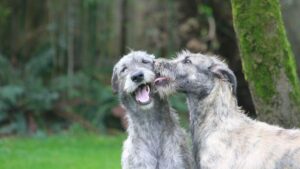
The Irish Wolfhound: A Breed That Has Stood the Test of Time
Discover the timeless allure and rich legacy of Irish Wolfhounds, from ancient origins to cherished companions today.
Home » Dog Breeds » Irish Wolfhound Dog Breed
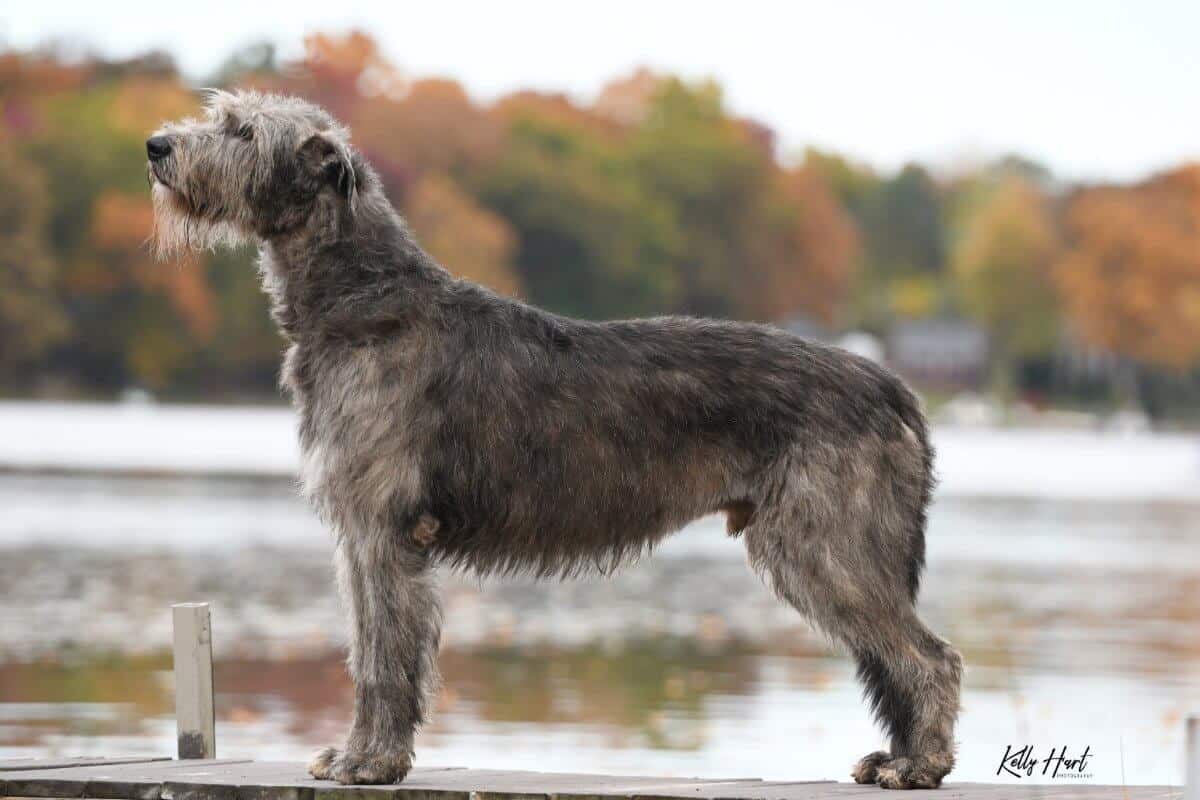
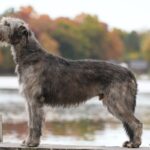
The Irish Wolfhound, hailed as the “gentle giant” of the canine world, stands as a symbol of grace, power, and antiquity. Hailing from Ireland, where it was originally known as cú faoil, the breed is renowned for its immense size and gentle temperament as well as for its legendary history. The Wolfhound’s kind-hearted nature obscures its ancient use as a hunter of stag, boar, and wolf.
Hound
30 – 32 Inches
105 – 120 Pounds
6 – 8 Years
| Country of Origin | Ireland |
|---|---|
| Bred For | Large Game Hunting, Companionship |
| Known For | Commanding Appearance, Gentleness, Great Size |
| Popularity | Moderate |
| Temperament | Dignified, Courageous, Calm |
| Activities | Coursing, Running, Hiking, Conformation Shows, Dog Sports |
The Irish Wolfhound, often referred to as a gentle giant, boasts an ancient lineage that traces back thousands of years. The breed’s history is steeped in folklore and is as majestic and intriguing as the big dog itself.
Originating from Ireland, as its name suggests, the Irish Wolfhound was primarily used as a dog of war and as a hunting companion. Historical accounts, some dating as far back as Roman times, speak of the breed’s prowess at hunting large game, particularly wolves and elk. The dog’s size, strength, and speed made them formidable hunters, capable of taking down the most challenging prey. It has been said Wolfhound’s were so efficient in their task that they played a significant role in the extinction of the Irish elk and the wolves of Ireland.
Apart from hunting, Irish Wolfhounds also played a crucial role in battles and in wars. They were used to pull men off horses and chariots, displaying both courage and loyalty on the battlefield. Their intimidating presence made them invaluable assets in combat situations.
Over time, as wolves became scarce in Ireland, the need for the Wolfhound declined. By the 19th century, the breed was on the brink of extinction. However, dedicated breed enthusiasts, particularly Captain George Augustus Graham, took it upon themselves to preserve and revive the breed. Graham and others crossbred the remaining hounds with other large breeds, including the the Great Dane and Scottish Deerhound, ensuring the continuation of the breed’s lineage.
The Irish Wolfhound ultimately garnered official recognition from major kennel clubs around the world. The American Kennel Club (AKC) recognized the breed in the late 19th century, classifying it as a member of the Hound Group. Meanwhile, the Fédération Cynologique Internationale (FCI) acknowledged the breed as part of its group of Sighthounds. The Royal Kennel Club in the UK has also been an advocate for the breed, upholding its Breed Standard and promoting its growth throughout the United Kingdom.
Today, the Irish Wolfhound stands not as a fierce hunter or warrior but as a beloved family companion and show dog. The breed’s noble history is a testament to its versatility, adaptability, and resilience.
Adult male Irish Wolfhounds typically measure 32 inches or more at the withers, while mature females usually stand at a height that exceeds 30 inches.
In terms of weight, mature males generally weigh in excess of 120 pounds, whereas adult females typically weigh in at 105 pounds or more.
The Irish Wolfhound is an imposing yet graceful sighthound, with a length that’s slightly longer than its height. The overall construction of the hound is one that combines power without compromising elegance. The breed’s substantial frame is well-muscled, ensuring strength as well as agility. A deep chest and long, strong limbs are a testament to the Wolfhound’s historic role as a hunter of formidable and fast-moving game.
Texture: The coat of the Irish Wolfhound is rough and hard in texture, especially long and wiry over the eyes and under the jaw. It’s a medium-length coat that serves to protect the hound from adverse weather conditions and the rough terrain on which it has historically hunted. Wooly or silky coats are unacceptable as they do not provide adequate protection in all types of weather.
| Standard Color | |
|---|---|
| Black | ee |
| Brindle | ee |
| Cream | ee |
| Gray | ee |
| Gray & Brindle | ee |
| Red | ee |
| Red & Brindle | ee |
| Red Wheaten | ee |
| Silver | ee |
| Wheaten | ee |
| Wheaten & Brindle | ee |
| Blue | ee |
| White | ee |
| Standard Marking | |
|---|---|
| Black Markings | ee |
| Gray Markings | ee |
| WhiteMarkings | ee |
A Note About Color: The Irish Wolfhound hard and wiry coat comes in several recognized colors, including any color that appears in the Scottish Deerhound.
The tail is long and moderately curved, but it does not curl over the back. It extends from a broad base and tapers to a point. In terms of placement, it is set on rather low. When the Wolfhound moves, the tail is carried with a slight upward arch; however, it is never raised above the level of the back. The coat on the tail is dense and rough, offering protection and adding to the hound’s distinguished appearance.
The Irish Wolfhound’s tail aids with balance and direction as the hound sprints after its quarry. When at rest, the tail hangs down, reaching beyond the hocks which showcases the breed’s calm and composed demeanor.
Choosing to bring an Irish Wolfhound into the home is a decision that comes with responsibility, especially given the breed’s size and specific needs. Known for their gentle temperament and majestic stature, these giants of the dog world have captivated hearts for centuries. Today’s prospective owners, however, should be aware of the breed’s unique requirements to be able to provide a relationship that’s harmonious for everyone.
The Irish Wolfhound, like all breeds and mixed breeds, can be predisposed to certain health conditions. Overall, dogs of this breed are robust, but given their size, they can sometimes be prone to issues that are common to giant dogs. Regular check-ups with a veterinarian who is familiar with the needs of this breed are essential.
Lifespan: Irish Wolfhounds, on average, have a life expectancy of around 6 to 8 years. However, with proper care and attention to the hound’s health needs, it’s not uncommon for some to live longer.
Irish Wolfhounds, due to their large size and specific genetics, are predisposed to certain health issues. Some of the more common concerns include:
It’s crucial for Irish Wolfhound owners to be vigilant and aware of these potential health risks. Regular check-ups, appropriate diagnostic tests, and early detection can make a significant difference in the outcome.
The personality of the Irish Wolfhound is that of gentle introspection, deep loyalty, and an almost regal calmness. For anyone wondering if the breed is suitable for novice owners, it is essential to consider a few factors.
While the Wolfhound’s temperament is forgiving and patient, the breed’s significant size and specific needs can be a challenge for those who are unfamiliar with caring for a giant dog. However, with proper guidance and a commitment to understanding the needs of the breed, a first-time owner can have a rewarding relationship with the breed.
When it comes to their sensitivity level, Wolfhounds are known to form deep bonds with their families. This sensitivity means they thrive best in environments where they are included as part of daily activities and are not left alone for extended periods. Prolonged solitude can lead to feelings of isolation and sadness.
As prospective owners consider how an Irish Wolfhound might fare with other dogs, it is comforting to know they generally get along well with their canine counterparts. The breed’s gentle nature means these hounds can coexist harmoniously with most other pets, although early socialization will always help to encourage smooth interactions.
Many potential owners of Wolfhounds ask about the breed’s suitability around young children. With its calm disposition, this breed is typically good with kids. However, due to its size, supervision is always recommended, especially when this giant hound is around very young children. Safety is an essential concern in this case, for both the kids and the dog.
When it comes to meeting strangers, the Irish Wolfhound’s historic usefulness as a guardian means these dogs can be reserved initially. However, once they sense there is no threat, they typically warm up and show their affectionate side.
Feeding an Irish Wolfhound appropriately is crucial to ensure it remains healthy and vibrant throughout their life. Given the breed’s large size, the dietary needs of a Wolfhound are understandably greater than those of smaller breeds.
When thinking about feeding a Wolfhound puppy, it’s important to provide a balanced diet that is rich in nutrients that support rapid growth. Puppies of the breed grow quickly, and their bones and muscles require just the right mix of protein, fats, and minerals. Premium puppy formulas designed specifically for large and giant breeds are recommended to meet these needs.
Feeding an adult Irish Wolfhound requires a slightly different approach. While it no longer grows at the same rate, the adult’s large size means its diet should still be rich in protein, to maintain muscle mass, and it should be provided with balanced fats for energy. On average, an adult Wolfhound can consume between 4 to 8 cups of high-quality dog food daily, though this can vary based on age, activity level, and metabolism.
Speaking of the amount of food, it’s not unusual for new Irish Wolfhound owners to seek guidance from feeding charts. While each dog is unique, and specific needs can vary, consulting with a veterinarian or a breed-specific guide can provide the ideal starting point.
It’s typically advised to feed Irish Wolfhounds at least twice daily to prevent bloat, a condition for which deep-chested breeds can be susceptible. This routine not only aids in digestion but also helps in keeping a hound’s energy levels consistent throughout the day.
Training an Irish Wolfhound can be a rewarding experience, especially given the breed’s gentle nature and eagerness to please. Although this hound’s majestic stature can sometimes be intimidating, beneath the imposing figure lies a sincere gentleness and a willingness to learn.
For those wondering about the ease of training a Wolfhound, it’s worth noting that these big dogs are generally responsive to positive reinforcement techniques. Their intelligence means they can pick up commands relatively quickly; however, it’s essential to remain patient and consistent throughout training sessions. Using treats, praise, and toys can effectively motivate these giants to follow commands and showcase their best behavior.
While the breed is not particularly known for being excessive barkers, the Irish Wolfhound can occasionally vocalize its feelings or alert its owners to something unusual. It’s essential to understand the cause of the barking and address it appropriately. For instance, a Wolfhound might bark out of boredom, in which case increasing the dog’s activity or providing it with interactive toys can help.
When it comes to the breed’s intelligence, the Irish Wolfhound is undoubtedly considered a smart dog by those who them it well. These dogs have a keen understanding of their surroundings and can often sense the emotions of their owners. However, their independent nature can sometimes make them appear aloof or stubborn, so it’s essential to establish leadership early on.
Regarding their wanderlust potential, it’s not uncommon for Wolfhounds to be curious about their environment. Their history as a hunting dog has given them a certain level of prey drive. While they’re generally good at staying within their assigned boundaries, it’s always a good idea to have a secure fence and provide supervision when outdoors.
It bears repeating that a predation instinct is still present in the breed. This means they might occasionally chase after smaller animals, so early socialization and training can help with managing this instinct. It’s important to always be aware of it, especially in areas with abundant wildlife.
Exercise is a pivotal aspect of Wolfhound life. Despite the breed’s imposing size, these giants are not necessarily high-energy dogs. They do require regular activity to maintain their health and happiness. Gentle exercises, especially during their growing phase, are crucial, given that strenuous activity can strain growing bones and expanding joints.
| Energy Level | Medium |
|---|---|
| Exercise Requirements | 1 Hour/Day (Minimum), Daily Walks, Regular Exercise, Playing with Another Dog, Mental Stimulation |
For anyone contemplating the exercise needs of an Irish Wolfhound, it’s important to understand that short daily walks and occasional sprints in a secured area are often enough. This breed has a moderate energy level, which means they aren’t as demanding as some smaller, high-energy breeds. However, regular movement that’s carefully monitored can help to prevent obesity and will keep muscles toned.
In terms of intensity, Wolfhounds do enjoy moments of playfulness, especially when they are puppies. As they mature, they tend to mellow and become more laid-back, but they still enjoy play sessions with their families. Offering them toys or interactive playtime can be a great way to bond and provide them with the mental and physical stimulation they need.
Lastly, while the Irish Wolfhound might appear stoic and composed, they have a playful side. Engaging in play sessions, offering them toys, and even participating in Agility or Lure Coursing can be a delightful experience for both the dog and the dog’s handler. Whatever the activity, it is important to be sure that any vigorous activity is suitable for the hound’s age and health, and to always provide an opportunity for rest and recovery.
When considering grooming an Irish Wolfhound, it’s worth noting that this breed has a rough and shaggy coat which gives it such a distinctive appearance. This, however, doesn’t mean these dogs are high-maintenance when it comes to grooming. Their coat is quite resistant to dirt and they don’t have oily skin, so they don’t require frequent baths. In fact, bathing them too often can strip the coat of its natural oils, which protect both their skin and their hair.
| Coat Type | Rough, Hard, Wiry |
|---|---|
| Grooming Requirements | Weekly Brushing, Occasional Bathing, Routine Ear Cleaning, Periodic Nail Trimming, Regular Tooth Brushing |
Irish Wolfhounds are moderate shedders. Regular brushing, about once a week, helps with removing the dead hair and prevents mats from forming. This will keep the coat looking its best and can provide an opportunity to check for skin issues or other health concerns.
Additionally, other aspects of grooming should be done as needed. Nails can grow quickly and, if left unattended, can cause discomfort and even lead to foot problems. Checking the ears for signs of infection or wax buildup, and brushing the teeth to prevent dental issues, should also be part of a comprehensive grooming routine.
Living with an Irish Wolfhound can be a truly rewarding experience, given the breed’s gentle temperament and affectionate nature. These giant dogs, despite their imposing stature, often see themselves as lap dogs and crave close companionship with members of their family.
When considering the suitability of the breed for apartment living, it may come as a surprise that an Irish Wolfhound can adapt easily to small environments, provided it receives adequate exercise. However, space can be a real concern due to the hound’s size. Ideally, a home with a yard where the dog can stretch its legs would be perfect, although it’s the quality of time and exercise given, not necessarily the living space, that matters most.
Weather sensitivity is another aspect to consider. Irish Wolfhounds have a dense undercoat that offers some protection against cold weather, but they’re not suited for extremely cold temperatures for prolonged periods. On the flip side, their thick coat can make them more susceptible to overheating in hot weather. During warm weather periods, it’s essential to provide them with a cool resting place and make sure they have access to fresh water at all times.
Irish Wolfhound puppies, like those of many giant breeds, grow rapidly and undergo a significant transformation in their first year. With their long legs, soft eyes, and playful demeanor, puppies of this breed can easily win the hearts of those around them. While they might look adorable and small for a short period, it’s important to remember these pups will grow into one of the largest dog breeds in the world. As such, early socialization and training, and understanding of their unique growth needs, are crucial first steps for supporting a healthy and happy adulthood.
Caring for an Irish Wolfhound puppy demands a lot of attention, especially in terms of diet and exercise. Given the pup’s rapid growth, a balanced and nutritious diet is essential to ensure proper bone and muscle development. It’s also important to consult with a veterinarian or a breed-specific expert on dietary recommendations.
Exercise is a vital aspect of puppy care too, but it must be approached with caution. Over-exercising a young Wolfhound can put undue stress on the developing bones and joints, leading to potential health issues later on. Short, controlled play sessions and brief walks are best until the pup reaches maturity.
Additionally, Irish Wolfhounds are sensitive as puppies, both physically and emotionally. They thrive on human companionship and should be included in daily family activities.
Lastly, while they may have a gentle demeanor, basic obedience training and early exposure to new people, places, and pups are crucial. These experiences help to ensure the Irish Wolfhound puppy grows up to be a well-mannered and sociable adult, given its enormous size and considerable strength.
The Irish Wolfhound, with its rich history as a hunting and war dog, has transitioned beautifully into the modern world, becoming a beloved family companion. Yet, the breed’s innate athleticism and sharp senses remain, making these hounds ideal candidates for a range of dog sports and activities.
It’s vital for owners and handlers of Irish Wolfhounds to remember the unique needs of this giant breed. Proper care, nutrition, and ensuring they are not over-exerted, especially in their formative years, will set them up for success in any activity they pursue.
The Irish Wolfhound is recognized by the world’s leading registries and kennel organizations, which categorize the breed into a specific Group based on its unique characteristics. This breed is recognized worldwide under the following Group designations:
| Organization | Group Designation |
|---|---|
| AKC (American Kennel Club) | Hound |
| UKC (United Kennel Club) | Sighthound and Pariah Dog |
| CKC (Canadian Kennel Club) | Hounds |
| ANKC (Australian National Kennel Council) | Hounds |
| RKC (The Royal Kennel Club) | Hound |
| FCI (Fédération Cynologique Internationale) | Group 10: Sighthounds; Section 2: Rough-Haired Sighthounds |
The ideal Irish Wolfhound is described by a Breed Standard that is approved by each of the world’s leading registries and kennel organizations. The Breed Standards for this breed may be found in the following links:
| Organization | Breed Standard |
|---|---|
| American Kennel Club | AKC Irish Wolfhound Breed Standard |
| United Kennel Club | UKC Irish Wolfhound Breed Standard |
| Canadian Kennel Club | CKC Irish Wolfhound Breed Standard |
| Australian National Kennel Council | ANKC Irish Wolfhound Breed Standard |
| The Royal Kennel Club | RKC Irish Wolfhound Breed Standard |
| Fédération Cynologique Internationale | FCI Irish Wolfhound Breed Standard |
Across the world, many clubs and organizations have been established to promote the well-being and proper breeding practices of the Irish Wolfhound. Members of these clubs work tirelessly to maintain the breed’s integrity, provide educational resources, and host events to bring enthusiasts together.
In the United States, the Irish Wolfhound Club of America (IWCA) is the premier organization dedicated to the breed. Founded in the early 20th century, the IWCA plays a pivotal role in upholding the Breed Standard, funding health research, and providing support to Wolfhound owners across the country.
In Canada, the Irish Wolfhound Club of Canada (IWCC) takes the lead. The IWCC not only focuses on the written Breed Standard and health research, it also promotes various activities, including specialty shows, lure coursing events, and educational seminars.
For enthusiasts in the United Kingdom, the Irish Wolfhound Club (IWC) shones as a beacon for the breed. Established in 1885 by Captain George Augustus Graham, the IWC holds the distinction of being the world’s oldest Irish Wolfhound club. With a storied history, this organization has been instrumental in preserving and promoting the breed for well over a century.
These clubs are more than mere organizations; they represent a community of Irish Wolfhound lovers, breeders, and owners who are united in their passion for this majestic breed.
An Irish Wolfhound can sometimes finds itself in need of rescuing due to any number of circumstances. Whether resulting from abandonment, neglect, or an owner who is unable to cope with the breed’s specific requirements, rescue groups play an indispensable role in providing these gentle giants a second chance at a loving home.
In the United States, the Irish Wolfhound Club of America (IWCA) not only focuses on promoting the breed but also running a dedicated rescue program. Members work diligently to ensure that any Wolfhound in need finds a forever home. The club’s network of volunteers assists with rescue, rehabilitation, and rehoming efforts.
Canada sees a similar commitment from members of the Irish Wolfhound Club of Canada (IWCC). Beyond the club’s role in breed promotion and hosting events, it includes members who are committed to rescue operations. Their efforts span the Canadian landscape, connecting abandoned or relinquished Wolfhounds with potential adopters.
For those in the United Kingdom, the Irish Wolfhound Rescue Trust provides critical support. Established with the aim of ensuring the well-being of Wolfhounds across Great Britain, this organization offers both rehoming services and valuable resources for potential adopters.
It’s essential to note that while there are breed-specific rescue groups, general animal shelters and rescue organizations may, on occasion, have an Irish Wolfhound available for adoption. It’s always worth checking local shelters when considering an adult Wolfhound as a family member.
Irish Wolfhounds do shed, although not as heavily as some other dog breeds. Their coarse and wiry coat requires regular brushing to remove loose hairs and prevent matting, and regular grooming helps to manage and reduce the amount of hair that’s found around the home.
Irish Wolfhounds are among the tallest dog breeds in the world. Males typically stand at least 32 inches tall at the shoulder, whereas females are slightly smaller, usually standing around 30 inches tall. Males typically weigh around 120 pounds, while females generally weigh about 105 pounds.
The lifespan of an Irish Wolfhound is relatively short when compared to small and medium-sized breeds. On average, these hounds live for about 6-8 years. However, with proper care, regular veterinary check-ups, and a healthy diet, some Irish Wolfhounds can live for 10 years or more.
No, Irish Wolfhounds are not considered hypoallergenic. While no dog is truly hypoallergenic, some breeds produce fewer allergens than others. It’s the shedding and the dander that can trigger allergies in sensitive individuals.
Absolutely! Irish Wolfhounds are often referred to as “gentle giants” because of their calm and affectionate nature. They are loyal, patient, and good with children, making them wonderful as family companions. However, their size requires ample space and careful consideration before a pup is brought home.
Historically, Irish Wolfhounds were bred for hunting large game such as the wolf and elk. In Ireland, their impressive size and strength made them ideal for hunting down and tackling such large prey. They also played a role as a war dog used to drag enemy warriors from horseback.
Irish Wolfhounds are not inherently aggressive. They are known for their gentle and calm demeanor, especially with their families. However, like many dogs, they can become protective if they perceive a threat. Early socialization and training are therefore crucial.
Both Irish Wolfhounds and Great Danes are among the tallest of dog breeds, but they differ in build and in weight. While the Irish Wolfhound is tall and lean, the Great Dane is typically more robust. In terms of height, they are comparable, but the typical Dane likely has a more substantial build. Individual size and substance, however, can vary within each breed.

Discover the timeless allure and rich legacy of Irish Wolfhounds, from ancient origins to cherished companions today.
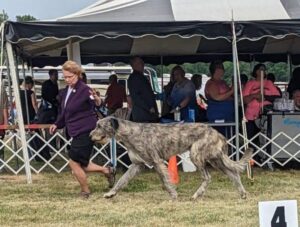
Jeanie Pitzenberger is the breeder behind the Boondocks Irish Wolfhounds. Read about the kennel’s beginnings, the puppies, and much more!
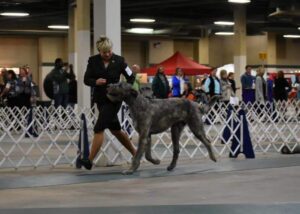
Interview with Hound Group Breeder Gail Morad – I live in Michigan. I breed Irish Wolfhound dogs. My kennel is named Darom Irish Wolfhounds.
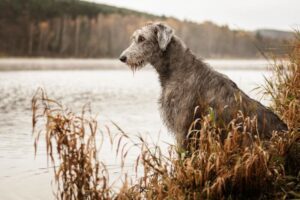
Interview with Hound Group Breeder Jill Bregy – Wildisle Reg. Irish Wolfhounds – My kennel name is Wildisle reg. and it is registered with
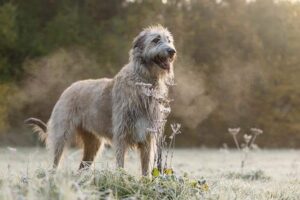
Judging Irish Wolfhounds – A Guide by Joel Samaha. Illustrations by Beverly Stobart and Robert Bernardi. The Irish Wolfhound Standard defines
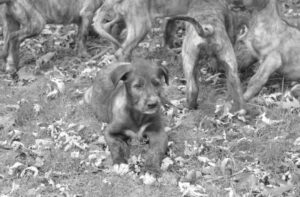
The Irish Wolfhound – Some Basic Information. Congratulations on your new Irish Wolfhound! To help you enjoy your IW and to promote the
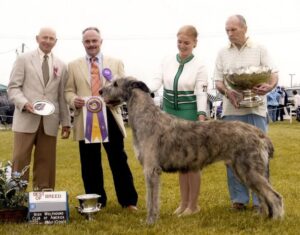
Purebred Irish Wolfhounds Breeder Linda Souza Limerick Irish Wolfhounds interview by Allan Reznik. Where did you grow up?

Discover the timeless allure and rich legacy of Irish Wolfhounds, from ancient origins to cherished companions today.

Jeanie Pitzenberger is the breeder behind the Boondocks Irish Wolfhounds. Read about the kennel’s beginnings, the puppies, and much more!

Interview with Hound Group Breeder Gail Morad – I live in Michigan. I breed Irish Wolfhound dogs. My kennel is named Darom Irish Wolfhounds.

Interview with Hound Group Breeder Jill Bregy – Wildisle Reg. Irish Wolfhounds – My kennel name is Wildisle reg. and it is registered with

Judging Irish Wolfhounds – A Guide by Joel Samaha. Illustrations by Beverly Stobart and Robert Bernardi. The Irish Wolfhound Standard defines

The Irish Wolfhound – Some Basic Information. Congratulations on your new Irish Wolfhound! To help you enjoy your IW and to promote the

Purebred Irish Wolfhounds Breeder Linda Souza Limerick Irish Wolfhounds interview by Allan Reznik. Where did you grow up?
The best way to ensure a long and happy relationship with a purebred dog is to purchase one from a responsible breeder. Not sure where to begin?
Contact the National Parent Club’s Breeder Referral Program, which is listed on the AKC Breeder Referral Contacts page.
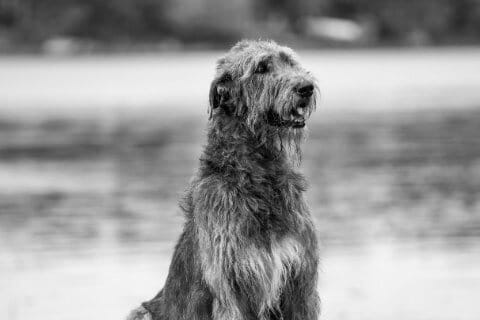

"*" indicates required fields
Showsight Magazine–the world’s most influential purebred dog publication since 1992. Each issue reaches a global audience dedicated to preserving the history and health of purpose bred dogs. Filled with award-winning editorial focused on news and insights from the dog show community, top breeders, handlers, AKC Judges, and more!